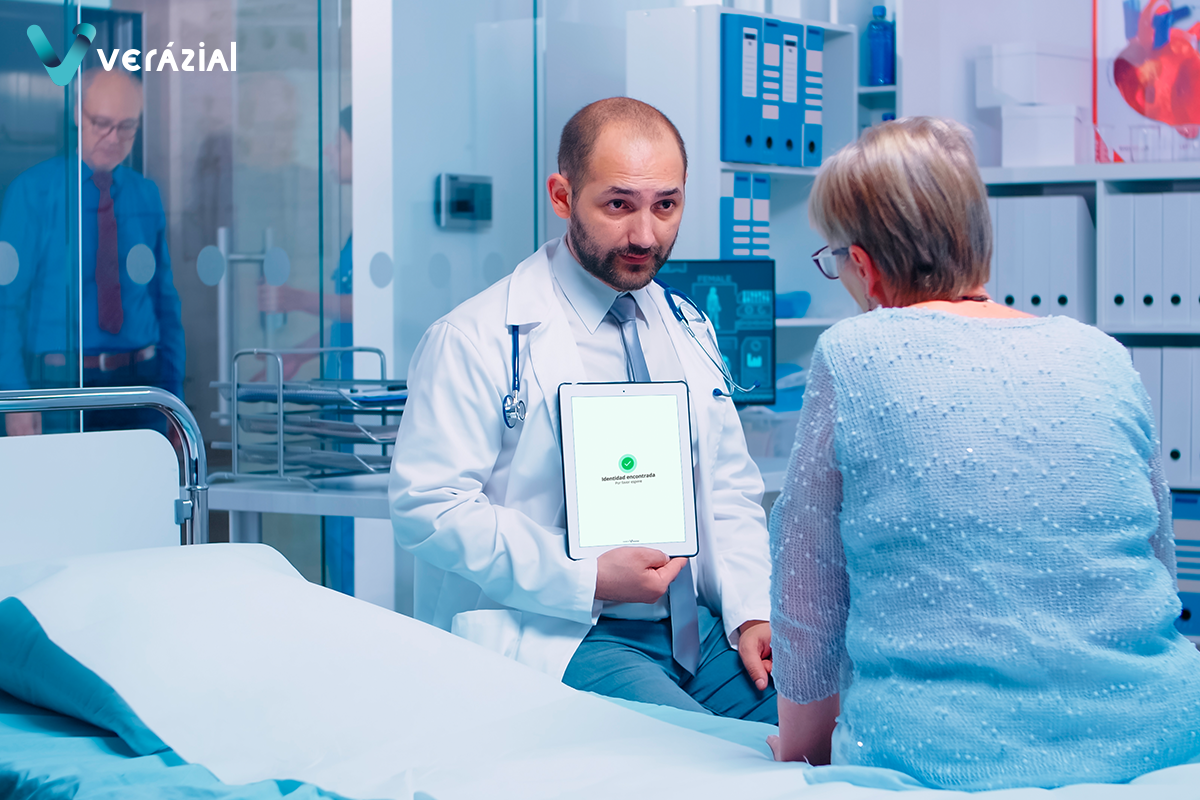Benefits of biometric technology for workers in healthcare environments
The implementation of biometric identification systems, such as fingerprints, facial recognition, or iris scanning, offers various benefits that improve the efficiency of daily operations carried out by healthcare staff in hospitals.
The main goal of healthcare is to provide proper medical care to those in need, but this process faces many daily challenges. Mistakes are still made that can have significant human, ethical, moral, and financial consequences for both the organization and the patients. These often avoidable errors compromise the health, well-being, and safety of the patients, weaken public trust, and increase healthcare costs.
Patient safety focuses on preventing harm and minimizing risks during medical care. To achieve this, it’s crucial for medical staff to follow organized protocols. These should include processes, values, procedures, behaviors, technologies, and care environments designed specifically to reduce risks, prevent avoidable harm, lower the chances of incidents, and lessen their impact if they do happen.
Common causes of patient harm include medication prescription errors, surgical failures, hospital-acquired infections, diagnostic mistakes, risky practices in blood transfusions and injections, and patient identification errors.
Accurate patient identification is essential for ensuring their safety. Patients need to be correctly identified at all times, and active verification should be a constant practice for all professionals involved in their care.
As we detailed in our article “Patient identification in the healthcare environment,” current patient identification measures still have unintentional errors due to insufficient identity verification security. This can lead to patient health damage, identity theft, increased economic costs, secondary victims, and loss of reputation of the hospital and its medical staff.
In the same way, in our article “Use of biometrics to improve patient safety“, we mentioned that the most effective way to ensure accurate identification in all medical procedures is by using biometric technologies. While it’s clear that patients, as primary users of the healthcare system, are the most protected by these techniques, they are not the only victims when an adverse event occurs. The professionals involved in the error also suffer, becoming what we call secondary victims.
Biometric technologies also help improve working conditions for healthcare professionals. Other involved parties, like doctors, healthcare staff, administrative personnel, and management, also benefit from secure biometric identification in their daily work.
Benefits of implementing biometric technology for healthcare workers

Implementing biometric identification systems, such as fingerprints, facial recognition, or iris scanning, offers numerous benefits that streamline daily operations and enhance safety standards in hospitals.
Increased security for staff
Biometric identification increases staff security in multiple ways. All personnel benefit from increased security in processes that require their unequivocal identification, both in physical access control to the facilities and in logical access to the information systems in place. This technology eliminates the possibility of theft or fraudulent use of passwords, as well as the loss of identification cards. Staff can be confident that their identity is effectively protected and that only they have access to critical areas and systems.
Convenience in identification
With biometric identification, access to hospital facilities and hospital management systems to obtain patient information becomes quick and easy, eliminating the need to memorize passwords or carry ID cards. Patient affiliations, admissions, identifications and discharges can be processed more quickly. For nurses, the worry of patient identification wristbands being lost or difficult to read is eliminated, improving efficiency in their daily tasks.
Increased job satisfaction
Reducing the time needed for self-identification and patient identification significantly simplifies work processes, eliminating many issues and inconveniences. This leads to a quieter, less stressful work environment, allowing staff to focus more on patient care and enjoy their work more. Improved efficiency and the elimination of daily frustrations translate into higher job satisfaction.
Enhanced confidence and legal protection
With biometric identification, staff can be completely at ease, free from concerns about identity theft for unauthorized medical procedures. Additionally, correct patient identification prevents staff from receiving incorrect information, reducing the likelihood of medical errors, misdiagnosis, or malpractice. This strengthens staff confidence in their ability to perform their work safely and accurately.
Improved service quality
Biometric implementation enhances system reliability and processes, thereby improving patient care. A secure and efficient identification system enables healthcare and administrative staff to deliver higher-quality service, ensuring patients feel well cared for. Improved service quality reflects in better work outcomes and increased satisfaction for both patients and hospital staff.
In the next article, we will explore the advantages of biometric technology in enhancing the operational efficiency of the entire organization.
Find out how Verázial ID Health can help you ensure the identification of your organization’s patients and employees.
Contact us for a demonstration and/or personalized study.
Referencias
- Side view nurses with masks [Freepik]
Benefits of biometric technology for workers in healthcare environments
The implementation of biometric identification systems, such as fingerprints, facial recognition, or iris scanning, offers various benefits that improve the efficiency of daily operations carried out by healthcare staff in hospitals.
The main goal of healthcare is to provide proper medical care to those in need, but this process faces many daily challenges. Mistakes are still made that can have significant human, ethical, moral, and financial consequences for both the organization and the patients. These often avoidable errors compromise the health, well-being, and safety of the patients, weaken public trust, and increase healthcare costs.
Patient safety focuses on preventing harm and minimizing risks during medical care. To achieve this, it’s crucial for medical staff to follow organized protocols. These should include processes, values, procedures, behaviors, technologies, and care environments designed specifically to reduce risks, prevent avoidable harm, lower the chances of incidents, and lessen their impact if they do happen.
Common causes of patient harm include medication prescription errors, surgical failures, hospital-acquired infections, diagnostic mistakes, risky practices in blood transfusions and injections, and patient identification errors.
Accurate patient identification is essential for ensuring their safety. Patients need to be correctly identified at all times, and active verification should be a constant practice for all professionals involved in their care.
As we detailed in our article “Patient identification in the healthcare environment,” current patient identification measures still have unintentional errors due to insufficient identity verification security. This can lead to patient health damage, identity theft, increased economic costs, secondary victims, and loss of reputation of the hospital and its medical staff.
In the same way, in our article “Use of biometrics to improve patient safety“, we mentioned that the most effective way to ensure accurate identification in all medical procedures is by using biometric technologies. While it’s clear that patients, as primary users of the healthcare system, are the most protected by these techniques, they are not the only victims when an adverse event occurs. The professionals involved in the error also suffer, becoming what we call secondary victims.
Biometric technologies also help improve working conditions for healthcare professionals. Other involved parties, like doctors, healthcare staff, administrative personnel, and management, also benefit from secure biometric identification in their daily work.
Benefits of implementing biometric technology for healthcare workers

Implementing biometric identification systems, such as fingerprints, facial recognition, or iris scanning, offers numerous benefits that streamline daily operations and enhance safety standards in hospitals.
Increased security for staff
Biometric identification increases staff security in multiple ways. All personnel benefit from increased security in processes that require their unequivocal identification, both in physical access control to the facilities and in logical access to the information systems in place. This technology eliminates the possibility of theft or fraudulent use of passwords, as well as the loss of identification cards. Staff can be confident that their identity is effectively protected and that only they have access to critical areas and systems.
Convenience in identification
With biometric identification, access to hospital facilities and hospital management systems to obtain patient information becomes quick and easy, eliminating the need to memorize passwords or carry ID cards. Patient affiliations, admissions, identifications and discharges can be processed more quickly. For nurses, the worry of patient identification wristbands being lost or difficult to read is eliminated, improving efficiency in their daily tasks.
Increased job satisfaction
Reducing the time needed for self-identification and patient identification significantly simplifies work processes, eliminating many issues and inconveniences. This leads to a quieter, less stressful work environment, allowing staff to focus more on patient care and enjoy their work more. Improved efficiency and the elimination of daily frustrations translate into higher job satisfaction.
Enhanced confidence and legal protection
With biometric identification, staff can be completely at ease, free from concerns about identity theft for unauthorized medical procedures. Additionally, correct patient identification prevents staff from receiving incorrect information, reducing the likelihood of medical errors, misdiagnosis, or malpractice. This strengthens staff confidence in their ability to perform their work safely and accurately.
Improved service quality
Biometric implementation enhances system reliability and processes, thereby improving patient care. A secure and efficient identification system enables healthcare and administrative staff to deliver higher-quality service, ensuring patients feel well cared for. Improved service quality reflects in better work outcomes and increased satisfaction for both patients and hospital staff.
In the next article, we will explore the advantages of biometric technology in enhancing the operational efficiency of the entire organization.
Find out how Verázial ID Health can help you ensure the identification of your organization’s patients and employees.
Contact us for a demonstration and/or personalized study.
Referencias
- Side view nurses with masks [Freepik]
Benefits of biometric technology for workers in healthcare environments
The implementation of biometric identification systems, such as fingerprints, facial recognition, or iris scanning, offers various benefits that improve the efficiency of daily operations carried out by healthcare staff in hospitals.
The main goal of healthcare is to provide proper medical care to those in need, but this process faces many daily challenges. Mistakes are still made that can have significant human, ethical, moral, and financial consequences for both the organization and the patients. These often avoidable errors compromise the health, well-being, and safety of the patients, weaken public trust, and increase healthcare costs.
Patient safety focuses on preventing harm and minimizing risks during medical care. To achieve this, it’s crucial for medical staff to follow organized protocols. These should include processes, values, procedures, behaviors, technologies, and care environments designed specifically to reduce risks, prevent avoidable harm, lower the chances of incidents, and lessen their impact if they do happen.
Common causes of patient harm include medication prescription errors, surgical failures, hospital-acquired infections, diagnostic mistakes, risky practices in blood transfusions and injections, and patient identification errors.
Accurate patient identification is essential for ensuring their safety. Patients need to be correctly identified at all times, and active verification should be a constant practice for all professionals involved in their care.
As we detailed in our article “Patient identification in the healthcare environment,” current patient identification measures still have unintentional errors due to insufficient identity verification security. This can lead to patient health damage, identity theft, increased economic costs, secondary victims, and loss of reputation of the hospital and its medical staff.
In the same way, in our article “Use of biometrics to improve patient safety“, we mentioned that the most effective way to ensure accurate identification in all medical procedures is by using biometric technologies. While it’s clear that patients, as primary users of the healthcare system, are the most protected by these techniques, they are not the only victims when an adverse event occurs. The professionals involved in the error also suffer, becoming what we call secondary victims.
Biometric technologies also help improve working conditions for healthcare professionals. Other involved parties, like doctors, healthcare staff, administrative personnel, and management, also benefit from secure biometric identification in their daily work.
Benefits of implementing biometric technology for healthcare workers

Implementing biometric identification systems, such as fingerprints, facial recognition, or iris scanning, offers numerous benefits that streamline daily operations and enhance safety standards in hospitals.
Increased security for staff
Biometric identification increases staff security in multiple ways. All personnel benefit from increased security in processes that require their unequivocal identification, both in physical access control to the facilities and in logical access to the information systems in place. This technology eliminates the possibility of theft or fraudulent use of passwords, as well as the loss of identification cards. Staff can be confident that their identity is effectively protected and that only they have access to critical areas and systems.
Convenience in identification
With biometric identification, access to hospital facilities and hospital management systems to obtain patient information becomes quick and easy, eliminating the need to memorize passwords or carry ID cards. Patient affiliations, admissions, identifications and discharges can be processed more quickly. For nurses, the worry of patient identification wristbands being lost or difficult to read is eliminated, improving efficiency in their daily tasks.
Increased job satisfaction
Reducing the time needed for self-identification and patient identification significantly simplifies work processes, eliminating many issues and inconveniences. This leads to a quieter, less stressful work environment, allowing staff to focus more on patient care and enjoy their work more. Improved efficiency and the elimination of daily frustrations translate into higher job satisfaction.
Enhanced confidence and legal protection
With biometric identification, staff can be completely at ease, free from concerns about identity theft for unauthorized medical procedures. Additionally, correct patient identification prevents staff from receiving incorrect information, reducing the likelihood of medical errors, misdiagnosis, or malpractice. This strengthens staff confidence in their ability to perform their work safely and accurately.
Improved service quality
Biometric implementation enhances system reliability and processes, thereby improving patient care. A secure and efficient identification system enables healthcare and administrative staff to deliver higher-quality service, ensuring patients feel well cared for. Improved service quality reflects in better work outcomes and increased satisfaction for both patients and hospital staff.
In the next article, we will explore the advantages of biometric technology in enhancing the operational efficiency of the entire organization.
Find out how Verázial ID Health can help you ensure the identification of your organization’s patients and employees.
Contact us for a demonstration and/or personalized study.
Referencias
- Side view nurses with masks [Freepik]
You May Also Like
You May Also Like





